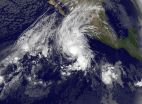(Press-News.org) Aging is the most significant and universal risk factor for developing neurodegenerative diseases, such as amyotrophic lateral sclerosis (ALS) and Alzheimer's, Parkinson's and Huntington's diseases. This risk increases disproportionately with age, but no one really knows why.
Now a team of scientists from Northwestern University, Proteostasis Therapeutics, Inc. and Harvard University has uncovered some clues. The researchers are the first to find that the quality of protective genes called molecular chaperones declines dramatically in the brains of older humans, both healthy and not, and that the decline is accelerated even more in humans with neurodegenerative disease.
Molecular chaperones are a special set of highly conserved genes that watch over cells, keeping them and the entire organism healthy by preventing protein damage.
The researchers specifically found the decline in 100 genes, approximately one-third of all human molecular chaperone genes. Then, with additional studies, they winnowed that number down to 28 human genes specifically involved in age-associated neurodegeneration. These critical genes provide a basis for a biomarker, an early indicator of disease and a target for new therapeutics.
"Imagine if we had biomarkers that tell doctors how you are doing in terms of aging, warning of any problems long before neurological deficits appear," said Northwestern's Richard I. Morimoto, one of the senior scientists on the study. "This would be a remarkable tool, especially considering the increases in life expectancy in many parts of the world.
"Let's say a person is age 50, but we see his molecular chaperones have declined and aren't repairing proteins and cellular damage. The chaperones are acting more like age 85 or 90. That's a sign that medical intervention could help," he said.
Morimoto is the Bill and Gayle Cook Professor of Biology in the Department of Molecular Biosciences and director of the Rice Institute for Biomedical Research in Northwestern's Weinberg College of Arts and Sciences.
"Molecular chaperones really are the barrier we have between disease and no disease," Morimoto said. "If this critical system declines, it leads to misfolded and damaged proteins, and eventually tissues become dysfunctional and die. If we can keep the chaperones healthy, we should be able to keep the person healthy."
The study will be published in the Nov. 6 issue of the journal Cell Reports.
To zero in on the subnetwork of 28 key genes, the scientists combined genomic analysis of human brain tissue, from both healthy individuals and those with neurodegenerative diseases (Alzheimer's, Parkinson's and Huntington's), with functional studies of C. elegans, a transparent roundworm. (The worm has a biochemical environment similar to that of human beings and is a popular research tool for the study of human disease.)
"To our surprise, the results from the studies of humans and C. elegans told us the same thing -- 10 percent of the 332 human genes are really important to cell health," Morimoto said. "Now we are down to 28 genes. This really tells us what to focus on."
After observing the dramatic decline in the health of molecular chaperones in humans both healthy and with neurodegenerative disease, the researchers systematically and individually "knocked down" all 219 chaperone genes in C. elegans (using neurodegenerative disease models) to see what effect the gene's absence had on an animal's function.
They identified a subnetwork of 16 molecular chaperone genes in C. elegans that are critical to preventing protein misfolding and damage to the cell. These genes correspond to 28 human "cousin" genes.
Humans encode approximately 25,000 genes, and getting any process down to a small number of genes will help scientists put their fingers on what's most important.
"It's a lot easier to enhance a handful of genes, such as those we've identified," Morimoto said. "The next step is to understand the basis for the decline of these specific chaperones and to develop treatments that prevent their decline. The goal is not to make people live forever but rather to match health span more closely with life span -- to improve the quality of life being lived."
INFORMATION:
The title of the paper is "A Chaperome Subnetwork Safeguards Proteostasis in Aging and Neurodegenerative Disease."
The co-first authors of the paper are Marc Brehme (co-supervised by Marc Vidal of Harvard and Hui Ge while at Proteostasis Therapeutics) and Cindy Voisine (a postdoctoral fellow in Morimoto's lab).
Other authors are Kai Orton, of Northwestern; Thomas Rolland and Marc Vidal, of the Dana-Farber Cancer Institute and Harvard Medical School; and Shinichiro Wachi, James H. Soper, Yitan Zhu, Adriana Villella, Dan Garza and Hui Ge, of Proteostasis Therapeutics, Inc.
Roughly one-third of the 700,000 United States troops who fought in the 1990-1991 Persian Gulf War have subsequently developed a distinct set of chronic health problems, dubbed Gulf War illness. Their symptoms, from fatigue, muscle pain and weakness to decreased cognitive function and gastrointestinal and skin problems, persist decades after the conflict.
In a study published in the Nov. 1 issue of Neural Computation, researchers at the University of California, San Diego School of Medicine report that a high quality brand of coenzyme Q10 (CoQ10) – a compound ...
NOAA's GOES-West satellite captured an image of Hurricane Vance and a much smaller developing low pressure area in the Eastern Pacific Ocean on Nov. 3. Vance's tropical-storm force winds extended to about 250 miles in diameter.
NOAA's GOES-West satellite captured an infrared image of the Eastern Pacific that showed Hurricane Vance was a couple of times larger than the developing low pressure area known as System 94E to the southeast of the hurricane. In the GOES image, taken Nov. 3 at 1200 UTC (7 a.m. EST/4 a.m. PST) clouds and showers extending from Vance's northern ...
Women are significantly underrepresented in many science, technology, engineering, and math (STEM) fields, and attempts to understand why have only resulted in disagreement among researchers, the lay public, and policymakers. In a comprehensive new report, an interdisciplinary team of psychological scientists and economists aims to cut through the confusion, synthesizing available research and providing a host of new analyses to identify the factors that drive women's underrepresentation in STEM. Their analyses show that, despite many differences between the sexes prior ...
New York | Heidelberg, 3 November 2014 -- A new theoretical work establishes a long-sought-after connection between nuclear particles and electromagnetic theories. Its findings suggest that there is an equivalence between generalised Casimir forces and those that are referred to as weak nuclear interactions between protons and neutrons. The Casimir forces are due to the quantisation of electromagnetic fluctuations in vacuum, while the weak nuclear interactions are mediated by subatomic scale particles, originally called mesons by Yukawa. These findings by Barry Ninham ...
This news release is available in French. A team of researchers from Inserm led by Paul Hofman (Inserm Unit 1081/University of Nice) has just made a significant advance in the area of early diagnosis of invasive cancers. In a study which has just been published in the journal PLOS ONE, the team shows that it is possible to detect, in patients at risk of developing lung cancer, early signs, in the form of circulating cancer cells, several months, and in some cases several years, before the cancer becomes detectable by CT scanning. This warning could play a key role in ...
WASHINGTON, Nov. 3, 2014 — As Carl Sagan famously said, "We are made of star stuff." It's a mind-boggling thought, but what exactly did he mean? Ahead of Sagan's birthday on November 9th, Reactions teamed up with the American Association of Chemistry Teachers (AACT) and best-selling author Sam Kean to explain the chemistry behind this iconic quote. Watch our latest episode to find out how many of the atoms that make up you (and everything else) were forged in the nuclear cores of stars billions of years ago. Watch the video here: http://youtu.be/2bm479V8qPs.
INFORMATION:
Kean's ...
This news release is available in Spanish. Biological membranes define the functional architecture of living systems: they are selectively permeable, maintain the chemical identity of the cells and intracellular organelles, and regulate the exchange of material between them. To control the transporting of ions and small molecules through cell membranes, highly specialised proteins that transport these molecules through the membrane are used. Recent advances in nanotechnology and nanofabrication have made it possible to synthesise and manufacture artificial compounds ...
CHICAGO (November 3, 2014): Researchers from the University Health Network in Toronto are hoping to improve the operational efficiency of bariatric surgery programs to increase access to care. Studies have shown that bariatric operations can alleviate chronic health issues like diabetes and arthritis for extremely obese people. Now the University Health Network researchers are trying to determine why many patients who are referred for a bariatric operation do not ultimately have the procedure performed, despite being in a publicly funded health care program. Findings ...
Virginia Commonwealth University (VCU) Massey Cancer Center researchers have developed the first and only tool that can accurately measure cancer health literacy (CHL) and quickly identify patients with limited CHL. This tool has the potential to improve communication and understanding between physicians and patients, which, in turn, could lead to better clinical outcomes.
Recently published in the Journal of Health Communications, the Cancer Health Literacy Study was conducted over four years and involved 1,306 African-American and Caucasian patients from Massey and ...
San Diego — A nasal vaccine in development by researchers at The University of Texas at Austin has been shown to provide long-term protection for non-human primates against the deadly Ebola virus. Results from a small pre-clinical study represent the only proof to date that a single dose of a non-injectable vaccine platform for Ebola is long-lasting, which could have significant global implications in controlling future outbreaks. This work is being presented Nov. 5 at the 2014 American Association of Pharmaceutical Scientists (AAPS) Annual Meeting and Exposition, ...

